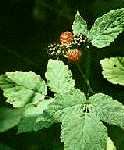 BLACKBERRY: Phytochemical Analysis
BLACKBERRY: Phytochemical AnalysisJump to Page Navigation Buttons===>>

This disappointing AGIS analysis shows few quantitative contents of any part of the blackberry plant. Blackberry leaves' high tannin content have made them a long-time diarrhea treatment. The berries are high in vitamin C (not shown here) and in dietary fiber, which helps health in may ways. I've made a comparison table for the berries at the end of this uninformative PhytoChem analysis table.
| Chemical | Part | Low (ppm) | High (ppm) |
|---|---|---|---|
| 2-HYDROXYURSOLIC-ACID | Plant | ||
| ARBUTIN | Leaf | ||
| ASCORBIC-ACID | Leaf | ||
| BETA-AMYRIN | Leaf | ||
| BETA-AMYRIN | Plant | ||
| BORON | Fruit | 0.1 | 21 |
| CHLOROGENIC-ACID | Fruit | ||
| FERULIC-ACID | Fruit | ||
| HYDROQUINONE | Leaf | ||
| INOSITOL | Leaf | ||
| LACTIC-ACID | Leaf | ||
| MALIC-ACID | Leaf | ||
| NEOCHLOROGENIC-ACID | Fruit | ||
| OXALIC-ACID | Leaf | ||
| RUBINIC-ACID | Plant | ||
| RUBITIC-ACID | Plant | ||
| SITOSTEROL | Plant | ||
| STIGMASTEROL | Plant | ||
| SUCCINIC-ACID | Leaf | ||
| TANNIN | Leaf | ||
| URSOLIC-ACID | Plant |

|
Info on blackberries was taken from a 1960's USDA Handbook 8, Composition of Foods. It is not included in the on-line USDA nutritional analysis database, which contains almost nothing about any fresh berries, even widely sold commercial ones like strawberries. Quantities reported (except fiber) are milligrams per 100 grams, as usual in Handbook 8 nutritional analyses. Commercial-agricultural orange (a nutritional pwoerhouse) is at the end of the table for comparison. |
|---|
| Fruit | Calcium | Phosphorus | Iron | Potassium | Vit. A | Vit. C | Fiber |
|---|---|---|---|---|---|---|---|
| Blackberry | 32 | 19 | 0.9 | 170 | 200 | 21 | 4.1 g |
| Black raspberry | 30 | 22 | 0.9 | 199 | trace | 18 | 5.1 g |
| Red raspberry | 22 | 22 | 0.9 | 168 | 130 | 25 | 3.0 g |
| Orange | 41 | 20 | 0.4 | 200 | 200 | 50 | 0.5 g |

 Plants Plants MENU |
|---|

CREDITS: The photo is from the University of Wisconsin (Madison) botany gopher.
Webmistress --Paula Giese.Text and graphics copyright 1996.
Last Updated: Sunday, January 14, 1996 - 6:01:10 AM